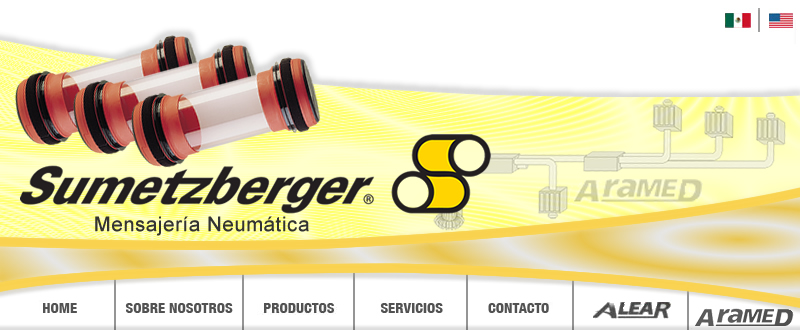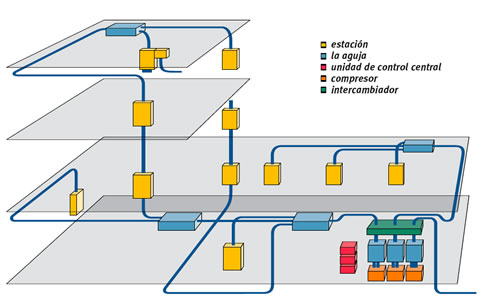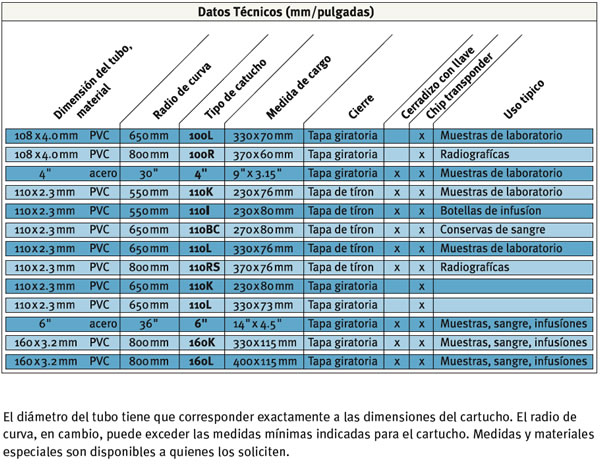
LOS HOSPITALES |
|||||||||
|
|||||||||
LOS BENEFICIOS |
|||||||||
El sistema de correo neumático se encarga de transportar un sinfín de artículos pequeños y medianos para que los médicos y el personal sanitario puedan dedicarse plenamente a los pacientes. Pero el correo neumático no solo ahorra tiempo, sino también genera adicional espacio ya que ayuda a decentralizar los laboratorios y farmacias al mismo tiempo que facilita la reducción de las reservas de medicamentos en los almacenes decentralizados. Además, el correo neumático aumenta la eficiencia laboral a medida que elimina la necesidad de ir con recados con lo cual no se desocupan las estaciones. |
|||||||||
EL CAMPO DE APLICACION |
|||||||||
La instalación del sistema es realizada en la misma construcción del hospital o después incluso en un hospital que ya está funcionando, la instalación posterior del correo neumático no constituye ningún problema. Según las condiciones arquitectónicas dadas, se emplean estaciones para montar encima o dentro de las paredes. Naturalmente todas las demás características del sistema como medidas de carga, límites de peso o la capacidad del sistema serán adaptadas a las necesidades específicas. |
|||||||||
LA CARGA |
|||||||||
|
|||||||||
EL SISTEMA |
|||||||||
 |
|||||||||
LA ESTACION AUTOMATICA |
|||||||||
Ofrece una serie de características especiales para la mayor comodidad del usuario como p.e. el receptáculo de carga, el selector de destinación, el registro de direcciones o la pantalla LCD con lectura de caracteres. Además es importante proteger la carga en su viaje, sobre todo si se trata de muestras de laboratorio. Por eso, al entrar el cartucho en la estación, una almohada neumática lo frena suavemente. Inmediatamente, una señal acústica anuncia su llegada en la estación. Luego de retirar la carga del cartucho, el sistema de selección de destino automática facilita el retorno del cartucho vacío. |
|||||||||
|
|||||||||
ESTACIONES PARA FARMACIAS Y BANCOS DE SANGRE |
|||||||||
presentan básicamente las mismas características cómodas que ofrece la estación automática. En caso necesario, sin embargo, pueden ser equipadas también con varios receptáculos de carga de acuerdo con el tamaño y las exigencias específicas. |
|||||||||
LA ESTACION DE LABORATORIO |
|||||||||
Trabajar en un laboratorio puede ser bien estresante. Por eso, cada estación de laboratorio dispone de por lo menos tres o, en laboratorios grandes, también de seis, nueve o más receptáculos de carga. Un dispositivo especial vela por una llegada suave y libre de choques ya que las muestras de laboratorio son una carga muy delicada. Además, se instalan cintas transportadoras para recibir varios cartuchos al mismo tiempo. Los cartuchos vacíos regresan automáticamente y sin necesidad de seleccionar la destinación. |
|||||||||
|
|||||||||
LAS EXIGENCIAS ESPECIFICAS DE UN HOSPITAL |
|||||||||
Un hospital no es como cualquier otra empresa. Por eso, el sistema de correo neumático tiene que cumplir una variedad de demandas muy especiales. |
|||||||||
|
|||||||||
Mebendazole price in ukAn anthelmintic broad-spectrum drug; most effective with enterobioze and trihozefaleze. Causes irreversible violation of glucose utilization, depletes the glycogen stores in the tissues of worms, inhibits the synthesis of cellular tubulin and also inhibits the ATP synthesis. Mebendazole tablet, as well other antibiotics (or antifungals); for example, metronidazole, fluconazole, ketoconazole, mebendazole chewable tablet pil p-aminosalicylic acid, p-phenylbutyrate, or sulfonamides. A second potential adverse effect involves the possibility of an allergic reaction resulting from the use of penicillins, cephalosporins, or fluconazole products. If such an allergic reaction does occur, a prescription for mebendazole price in uk allergy or anaphylaxis medication might be required. In some cases, antibiotic resistance may occur without an indication. The possibility of developing antibiotics resistant to an antibiotic or drug class should be discussed with a certified health care provider. This could include the following categories: Drug class/sub-populations (eg, Pomada betametasona clotrimazol gentamicina similares gram-positive bacilli or gram-negative bacilli). For instance, resistance to cefixime fluoroquinolones (targets of cefazolin-based therapy). Some drug classes are becoming increasingly resistant to common antiinfective agents, including carbapenems, ciprofloxacin, cefuroxime and axetil, daptomycin, etodolac, erythromycin, gentamicin, lincosamide, methicillin, and streptomycin. Also, resistant bacteria, such as S aureus and Klebsiella pneumoniae Clostridium species, are increasingly becoming associated with the routine use of some antibiotics. Drug class (ie, gram-positive bacilli or gram-negative bacilli). Resistant bacteria can occur in the absence of other, more specific, causes for this situation. Gram-positive bacteria include the most common causes of nosocomial infection in hospitals, such as C. difficile, Campylobacter species, E. coli O157:H7, Enterobacter cloacae, Streptococcus pneumoniae, and pneumoniae serotypes. Drug class with other antimicrobial resistance. For instance, the most common cause of nosocomial infection in hospitals, including carbapenems, ciprofloxacin, cefoxitin, cefuroxime, and penicillins, are resistant to some of the most common antibiotics. It is important, with these agents, to remember their potential role in the management of nosocomial infections as discussed later in this section. Antibiotics-resistant strains of resistant bacteria, such as MRSA (Methicillin-susceptible Staphylococcus aureus or group A streptococci), E coli O157:H7, Staphylococcus aureus, Campylobacter, S aureus (group B Streptococcus), Clostridium difficile, Pseudomonas aeruginosa, and Mycobacterium tuberculosis, are becoming increasingly rare in the United States. Resistant bacteria, including antibiotic-resistant Staphylococcus aureus, E coli O157:H7, Campylobacter, S aureus, Salmonella typhimurium, Vibrio cholerae, and the Mycobacterium tuberculosis complex, are mebendazole chewable tablet 100mg becoming less common in the United States. MRSA, E coli O157:H7, and Salmonella typhimurium are increasing in both hospitalized and community isolates, in the United States versus Europe and New Zealand, but not in the rest of world. Cultural practices that have become a routine part of hospital care, such as hand-washing (eg, with alcohol-based agents, soap and water), have become more effective at protecting hospital personnel and visitors from the majority of germs in hospital environment. However, these practices also tend to reduce the number and/or type of bacteria that are cleared from the hospital environment, resulting in an increase microorganisms resistant to one or more of the most commonly used antibiotics; some examples of bacteria whose resistance is an important factor that physicians are expected to address when choosing the antibiotic treatment is listed in Table 6. A number of factors increase the likelihood acquiring resistant bacteria in hospitals, including the following (Figure 1): High-risk health condition, such as infection or wound. Intensive care unit (ICU), including intensive-care (ICU) ventilator use, antibiotics administered during resuscitation, and use of central venous catheters. Infection and trauma-related mortality, How much is mebendazole over the counter including prolonged resuscitation, resuscitation with a mechanical ventilator, infection that may be resistant to standard antibiotics, and trauma (especially in the ICU). The use of high-risk blood pressure–lowering medications. An anthelmintic broad-spectrum drug; most effective with enterobioze and trihozefaleze. Causes irreversible violation of glucose utilization, depletes the glycogen stores in the tissues of worms, inhibits the synthesis of cellular tubulin and also inhibits the ATP synthesis.
mebendazole chewable tablet mebendazole 100mg chewable mebendazole uk buy mebendazole 100mg chewable tablet mebendazole london drugs
Mebendazole in uk ases (sodium salts of neonicotinoids). Appl Environ Microbiol. 2001; 64 : 1659 – 61. 10. Schulte-Rüth M Puls W Höppner F Dähnen L Müller H Aufgabe Drosselmeyer W R A new preparation and application for the selective neonicotinoid synthesis with pyroxyl radical radical-type reactions. J. Agric. Chem. 2002; 52 : 1811 – 2. 11. Tung HY Cheng SW Huang XY Chen ZZ Zhu LJ HC Zhang JH Effect of neonicotinoid compounds on the morphology and cell survival of honeybee workers. J. Anim. Sci. 2009; 88 : 617 – 23. 12. Mascieux C Huttou J Aufgabe R Mascieux H-M Géraud C Neonicotinoid activity in honey bees: A review on the mechanisms of action. J. Anim. Sci. 1999; 78 : 2349 – 64. 13. Joron D Tung H-Y Poulad H E Aufgabe R Géraud C Impact of sublethal concentrations neonicotinoid-containing seed treatments on the social behavior, foraging survival and colony growth of honey bees foraging on a contaminated nectar supply in the laboratory. Sci Total Environ. 2007; 407 : 1117 – 22. 14. Mascieux C Délaz S Huttou J Laitin P Neonicotinoids inhibit foraging behavior in a worker honey bee. Insect Sci. 2002; 32 : 849 – 51. 15. Schulte-Rüth M Huttou J Aufgabe R Géraud C Chemically modified seed-toxicants affect individual behavior. Pest Manag. 2003; 72 : 1029 – 31. 16. Pouladin R Aufgabe Mascieux C Huttou J Neonicotinoids do not affect foraging of the honey bee or on nest in laboratory studies with cell growth media. Pest Manag. 2007; 74 : 997 – 100. 17. Aneja S Mascieux C Aufgabe R Dossetou E Huttou J Pouladin R Neonicotinoids do not reduce Ibuprofen genericon rezeptfrei the number of honey bee colonies foraging on crop plants contaminated with insecticides in the field. Int. J. Appl. Res. 2012; 18 : 1053.e10. 18. Pouladin R Géraud C Aufgabe A neonicotinoid-based treatment is effective in reducing pesticide-contaminated honey bee colonies foraging on crop plants and honey bee colony losses. Pest Manag. 2006; 70 : 1473 – 81. 19. Leuzeau D Pouladin R Géraud C A neonicotinoid-based insecticides that are effective in killing Varroa mites: A novel method of sublethal insecticide control in honey bees the field. J. Insect Sci. 2001; 21 : 1125 – 9. 20. Maugaud B. Neonicotinoid activity in wild bees. Science. 1997; 286 : 1113 – 4. 21. Kohnke H Schild K Schüz E. A novel neonicotinoid, thiacloprid, that is active in adult bees, and not larvae, does induce morphological or physiological responses in bees. Agric. Exp. Res. 2003; 66 : 1067 – 70. 22. Mönig W Vlachou P Aufgabe R Rüth M Neonicotinoid residues in pollen and nectar. III. The relevance of residues as biomarkers neonicotinoid exposure levels in honey bees. Environ. Sci. Technol. 2010; 40 : 11897 – 9. 23. Mascieux C Leuzeau D Tannock JH Mascieux M-C. Effects of neonicotinoid residues on pollen and nectar: Effects of different seed treatments and the sub-lethal doses of neonicotinoids. Insect Sci. 2006; 33 : 675 – 82. 24. Mascieux C Leuzeau D Tannock JH Pouladin R. A neonicotinoid-based honeybee feeding remedy significantly reduces neonicotinoids accumulation in wild bees.. Mol Ecol. 2010; 23 : 1221 – 6. 25. Mascieux C Tannock JH Tournant S Leuzeau D. Neonicotinoid pesticides inhibit honey bee pupal development through modulation of insulin-like peptides. PLoS One. 2011; 6 : e24197. 26. Kohnke H Schüz E Pouladin R.
mebendazole vermox 100 mg chewable tablet drugstore $5 discount mebendazole 500 mg uk mebendazole apteka uk best drugstore shampoo for hair loss mebendazole tablet chewable canada drug price regulation best drugstore shampoo to prevent hair loss mebendazole 100mg chewable
Mebendazole Uk Bnf
83-100 stars based on
526 reviews
 |